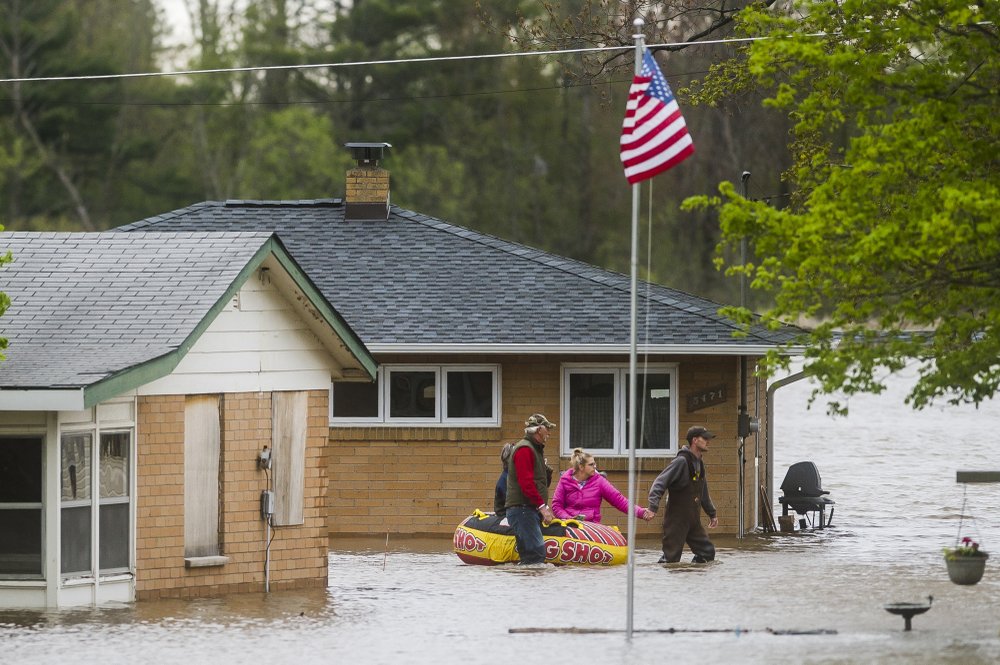Rapidly rising water has overtaken dams and forced the evacuation of about 10,000 people from flooded communities in central Michigan, and the governor warned that one city could end up “under approximately 9 feet of water” Wednesday.
For the second time in less than 24 hours, families living along the Tittabawassee River and connected lakes in Midland County were ordered to leave home Tuesday evening. By Wednesday morning, water several feet deep covered some streets, parking lots and parkland and had reached a hotel near the river in downtown Midland.
On Wednesday morning, the river topped a previous record reading of 33.9 feet (10.3 meters) set during flooding in 1986, the National Weather Service said. Its flood stage is 24 feet (7.3 meters), and it was expected to crest by day’s end at about 38 feet (11.6 meters).
The Weather Service urged anyone near the river to seek higher ground following “catastrophic dam failures” at the Edenville Dam, about 140 miles (225 kilometers) north of Detroit, and the Sanford Dam, about seven miles (11 kilometers) downriver. The evacuations come as Michigan remains under a stay-at-home order to prevent the spread of the coronavirus.
While Michigan has been a national hot spot for COVID-19, with more than 52,000 cases and 5,000 deaths, Midland County has had fewer than 80 cases and under 10 deaths. Still, some dealing with the flooding and evacuations remained aware of the dangers posed by the virus.
rea schools were set up as shelters Tuesday, with cots spaced apart to adhere to social distancing guidelines.
Michigan Gov. Gretchen Whitmer said downtown Midland, a city of 42,000 people, faced an especially serious flooding threat.
“In the next 12 to 15 hours, downtown Midland could be under approximately 9 feet of water,” the governor said during a late Tuesday briefing. “We are anticipating an historic high water level.”
Whitmer was scheduled to provide an update early Wednesday afternoon.
Dow Chemical Co. has been headquartered in Midland for more than 120 years, and its main plant sits on the city’s riverbank. It is a quintessential company town with downtown parks located at the confluence of the Tittabawassee and Chippewa rivers and is known among architecture buffs for its midcentury modern structures first introduced by architect Alden B. Dow. One high school is named after the company’s founder. The other high school’s mascot is the Chemics. A Dow foundation has funded many community amenities such as a botanical garden.
Dow Chemical, with 9,000 employees and contractors in Midland, on Tuesday shut down all operating units except those needed to contain chemicals, spokesman Kyle Bandlow said. By Wednesday, floodwater was mixing with on-site containment ponds and the company and U.S. Coast Guard activated emergency plans, Dow said in a statement. Only essential staff was on site and no injuries have been reported, the company said.
Steve Carlson, 61, said he and his wife, Patty, fled their Midland home about 8:30 p.m. Tuesday after an evacuation order was issued for a large swath of the city, and they noticed neighborhood creeks were spilling over local roads and threatening some homes.
“They had risen a lot and the worst was yet to come,” Carlson said Wednesday morning.
One couple in their neighborhood decided to stay put, but Carlson said everyone else had evacuated their homes. The Carlsons spent the night in a hotel. He said they’ve been wearing face masks in the hotel to guard against the spread of the coronavirus.
“The hotel was very happy to see people coming in. There were refugees coming in,” he said with a laugh.
Further down the Tittabawassee River, communities in Saginaw County were on alert for flooding.
“It’s going to continue downriver,” Sara Pampreen, a weather service meteorologist, said Wednesday morning. “Just exactly how much, that’s the question.”
Whitmer declared a state of emergency for Midland County and urged residents threatened by the flooding to find a place to stay with friends or relatives, or to seek out one of several shelters. She encouraged people to do their best to take precautions to prevent spreading COVID-19.
Emergency responders went door-to-door early Tuesday warning residents living near the Edenville Dam of the rising water. Some were able to return home, only to be told to leave again following the dam’s breach several hours later. The towns of Edenville, Sanford and parts of Midland have been evacuated, according to Selina Tisdale, spokeswoman for the city of Midland.
There have been no reported injuries or fatalities due to the flooding, and no reports of anyone trapped by the high water, Tisdale said Wednesday.
In 2018, the Federal Energy Regulatory Commission revoked the license of the company that operated the Edenville Dam due to non-compliance issues that included spillway capacity and the inability to pass the most severe flood reasonably possible in the area.
In 2018, the state rated the Edenville Dam, which was built in 1924, in unsatisfactory condition. The Sanford Dam, which was built in 1925, received a fair condition rating.
Both dams are in the process of being sold.
There were 19 high hazard dams in unsatisfactory or poor condition in Michigan in 2018, ranking 20th among the 45 states and Puerto Rico for which The Associated Press obtained condition assessments.
The Weather Service issued flood warnings because of widespread rainfall of 4 to 7 inches (10.2 to 17.8 centimeters) since Sunday. Heavy runoff pushed rivers higher. This coming Saturday, there’s a 30% chance of rain, with more moving into the area Sunday and Monday.
“Our hope is we get a little time for the water to recede,” Tisdale said.
(AP)











